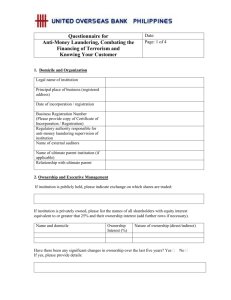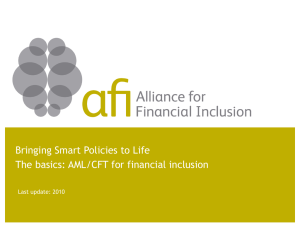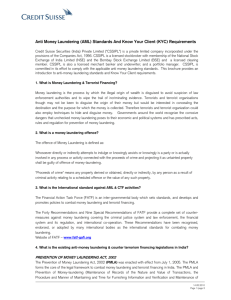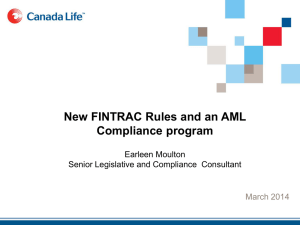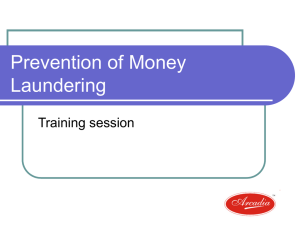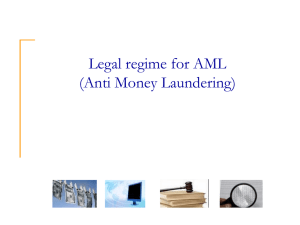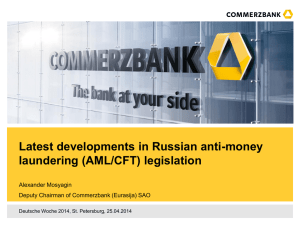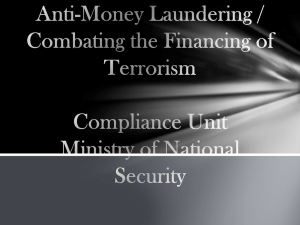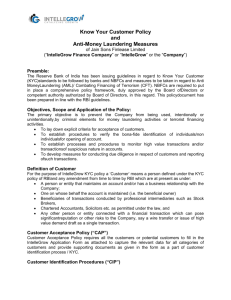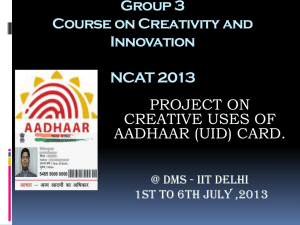Presentation
advertisement
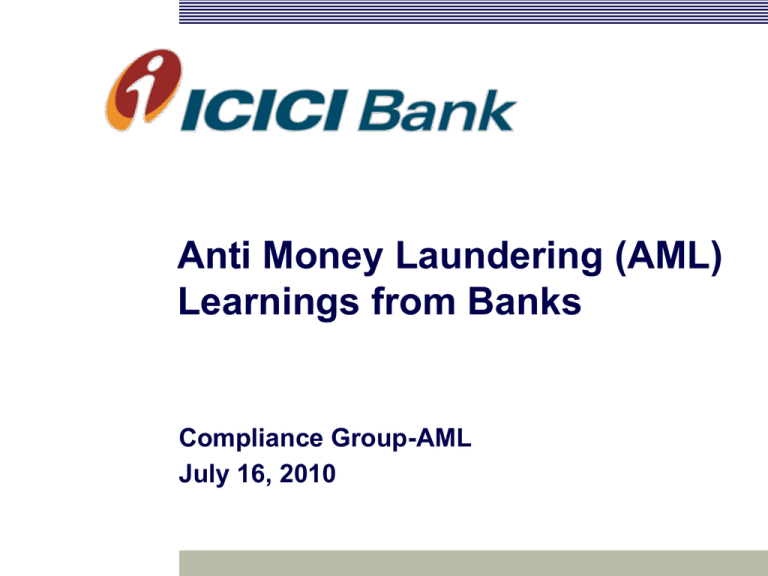
Anti Money Laundering (AML) Learnings from Banks Compliance Group-AML July 16, 2010 Agenda KYC/ AML/ CFT Overview The 3D approach Banks V/s Insurance Companies Controls &ofChecks Elements AML Framework in Banks Summary 2 Agenda KYC/ AML/ CFT Overview The 3D approach Banks V/s Insurance Companies Controls &ofChecks Elements AML Framework in Banks Summary 3 Know Your Customer (KYC) Reserve Bank of India (RBI) circular on AML/ KYC states: “The objective of KYC/AML/CFT guidelines is to prevent banks from being used, intentionally or unintentionally, by criminal elements for money laundering or terrorist financing activities. KYC procedures also enable banks to know/understand their customers and their financial dealings better which in turn help them manage their risks prudently” Banks should frame their KYC policies incorporating the following four key elements: a) Customer Acceptance Policy; b) Customer Identification Procedures; c) Monitoring of Transactions; and d) Risk Management. 4 What is Money Laundering? Section 3 of the Prevention of Money Laundering Act (PMLA), 2002 defines the offence of money laundering as under: “ 3. Whosoever directly or indirectly attempts to indulge or knowingly assists or knowingly is a party or is actually involved in any process or activity connected with the proceeds of crime and projecting it as untainted property shall be guilty of offence of money laundering”. 'Money Laundering' is the process by which illegal funds and assets are converted into legitimate funds and assets The International monetary fund in 1996 estimated per year laundering volume between USD 600 bn and USD 1.5 tn. Illegal/ Dirty money 5 Legal/Clean Money Stages of Money Laundering A/c 3 A/c 6 A/c 4 A/c 7 A/c 1 A/c 9 A/c 2 A/c 5 Placement Investment A/c 8 Layering Placement Stage - easy to detect start of ML Layering Stage - Relatively Difficult to detect Integration Stage - Almost impossible to detect 6 Integration What is Terrorist Financing? The United Nations International Convention for the Suppression of the Financing of Terrorism broadly defines an act of terror as: a) An act which constitutes an offence within the scope of and as defined in one of the treaties listed by the United Nations (UN); or b) Any other act intended to cause death or serious bodily injury to a civilian, or to any other person not taking an active part in the hostilities in a situation of armed conflict, when the purpose of such act, by its nature or context, is to intimidate a population, or to compel a government or an international organisation to do or to abstain from doing any act. The act of financing such an act of terror can be termed as Terrorist Financing. 7 Money Laundering V/s Terrorist Financing Money Laundering Motive Profit Source of funds Il egal Volume of funds Large Modus operandi Front Companies Final effect Drain of the country's resources 8 Terrorist Financing Ideological Legal + Il egal Small Charities + Individuals Acts of Terror The AML Transition in India for Banks 9 August 16, 2002 - The Reserve Bank of India (RBI) released its first circular on “Guidelines on "Know Your Customer" norms and “Cash transactions” January 17, 2003 – Prevention of Money Laundering Act (PMLA) published in the Gazette November 24, 2004 - The first set of comprehensive guidelines on 'Know Your Customer' (KYC) Guidelines – Anti Money Laundering Standards issued July 1, 2005 – PMLA Rules November 27, 2006 – India becomes an 'observer' at the Financial Action Task Force (FATF) March 6, 2009 – Amendment to PMLA, 2002 November 12, 2009 – Amendment to PMLA Rules, 2005 June 25, 2010 – India becomes a member of the FATF AML framework in India Prevention of Money Laundering Act,2002 (PMLA) Prevention of Money Laundering Rules Reporting Agencies Regulatory Agencies RBI Master Circular on KYC/AML/CFT/ Banking Company RBI Obligation of Banks under PMLA, 2002 Financial Institutions IRDA Intermediaries SEBI Regulatory Agencies RBI Enforcement Agencies SEBI IRDA Enforcement Agencies IB FIU-IND RAW IB REIC CBDT-DGIT/CCIT RAW CBEC-DGDRI/DGCEI REIC CBDT-DGIT/CCIT ED CBEC-DGDRI/DGCEI EOW of Police EOW of CBI ED EOW of Police EOW of CBI Foreign FIUs Foreign FIUs Scheduled Offences included in PMLA 2009 Drug Trafficking Smuggling (arms, people, goods) Kidnapping Criminal Activities Extortion Bribery & Corruption Prostitution Terrorist Act 11 Counterfeiting & Forgery Gambling, Robbery, Cheating Agenda KYC/ AML/ CFT Overview The 3D approach Banks V/s Insurance Companies Controls &ofChecks Elements AML Framework in Banks Summary 12 AML approach-3D Concept Deterring Adherence to KYC Norms Activity Indicators Detecting Transaction Monitoring Disrupting 13 Reporting transactions Agenda KYC/ AML/ CFT Overview The 3D approach Banks V/s Insurance Companies Controls &ofChecks Elements AML Framework in Banks Summary 14 Risk Comparison between Insurance & Banking CIP/ ML/ TF Risk Comparison 3 2 Insurance Banking 1 0 C us tom er Identific ation 0-1: Low Risk 1-2: Medium Risk 2-3: High Risk 15 Money Laundering T errorist F inanc ing Risk Comparison between Banking & Others CTR/ STR/ CCR comparison 100 90 80 70 60 CTRs STRs CCRs 50 40 30 20 10 0 Banking Others Figures in percentage for the FY 2008-09 (Source: FIU Annual Report) 16 Agenda KYC/ AML/ CFT Overview The 3D approach Banks V/s Insurance Companies Controls &ofChecks Elements AML Framework in Banks Summary 17 Elements of AML Framework in Banks Know Your Customer (KYC) Enterprise Wide AML Framework Transaction Monitoring Due diligence measures •Basic •Enhanced Centralised Account Opening Centers Name Screening •Account opening stage •Legacy customers •Screening of Cross Border Transactions Performed on the basis of pre defined rules based on product , customer and transaction risk Identification of unusual transactions Confirmation of Suspicion Training FIU Reporting* Regulatory Interface Updates to Senior Mgmt Audit * Includes STR, CTR, CCR, NPOR 18 Typologies observed Large value and volume of cash deposits followed by immediate RTGS payment or transfer. Large value of RTGS or transfer followed by immediate withdrawal/ transfers. Issuing large number of cheques. Cash deposits across various branches followed by withdrawals, transfer. Frequent closure and subsequent opening of accounts. Sudden activity in a dormant account. 19 Typologies observed ...contd High number of debit and credits by way of small value cheques. Large value inward remittance followed by cash withdrawals. Inward remittance to one account followed by small value transfers to multiple accounts Inward remittance from a high risk country followed by cash withdrawal from a third party bank ATM located in a sensitive area Deposit and withdrawal of cash from multiple locations in one account all being non base branches/ ATMs 20 Agenda KYC/ AML/ CFT Overview The 3D approach Banks V/s Insurance Companies Controls &ofChecks Elements AML Framework in Banks Summary 21 Summary Appointment of Principal Officer Creation of KYC/ AML/ CFT framework Understanding the industry & product vulnerabilities to ML/ TF Awareness about the various typologies related to the products Timely & effective reporting to FIU-IND 22 Thank you 23
